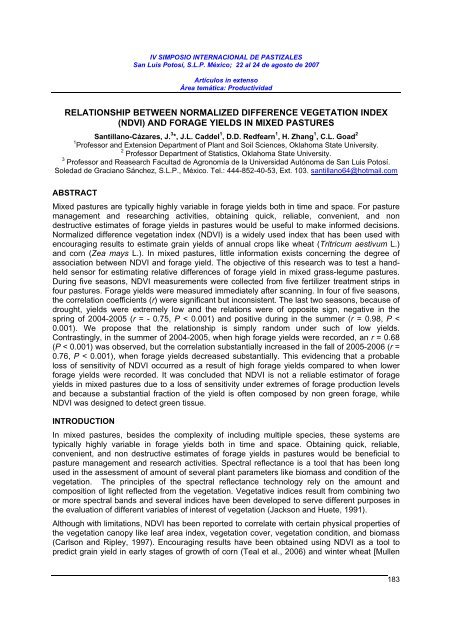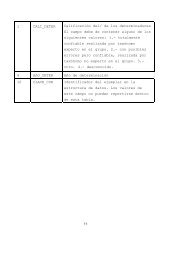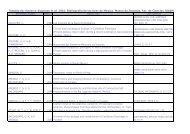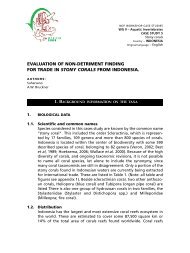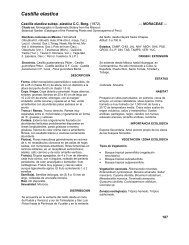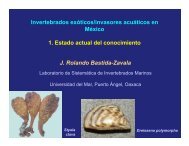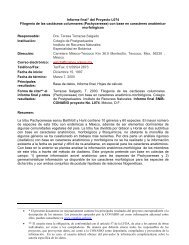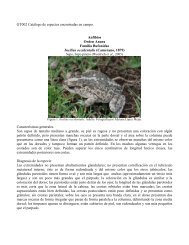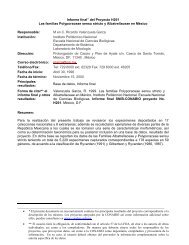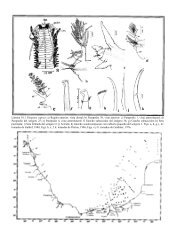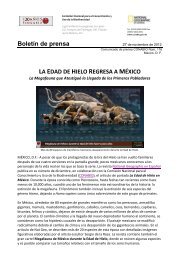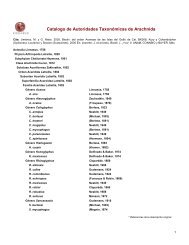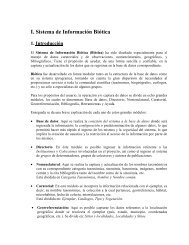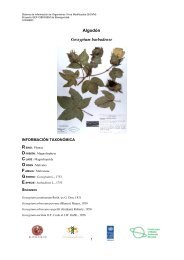ecosystem services to and from north american arid ... - Conabio
ecosystem services to and from north american arid ... - Conabio
ecosystem services to and from north american arid ... - Conabio
You also want an ePaper? Increase the reach of your titles
YUMPU automatically turns print PDFs into web optimized ePapers that Google loves.
IV SIMPOSIO INTERNACIONAL DE PASTIZALES<br />
San Luis Po<strong>to</strong>sí, S.L.P. México; 22 al 24 de agos<strong>to</strong> de 2007<br />
Artículos in extenso<br />
Área temática: Productividad<br />
RELATIONSHIP BETWEEN NORMALIZED DIFFERENCE VEGETATION INDEX<br />
(NDVI) AND FORAGE YIELDS IN MIXED PASTURES<br />
Santillano-Cázares, J. 3 *, J.L. Caddel 1 , D.D. Redfearn 1 , H. Zhang 1 , C.L. Goad 2<br />
1<br />
Professor <strong>and</strong> Extension Department of Plant <strong>and</strong> Soil Sciences, Oklahoma State University.<br />
2<br />
Professor Department of Statistics, Oklahoma State University.<br />
3<br />
Professor <strong>and</strong> Reasearch Facultad de Agronomía de la Universidad Autónoma de San Luis Po<strong>to</strong>sí.<br />
Soledad de Graciano Sánchez, S.L.P., México. Tel.: 444-852-40-53, Ext. 103. santillano64@hotmail.com<br />
ABSTRACT<br />
Mixed pastures are typically highly variable in forage yields both in time <strong>and</strong> space. For pasture<br />
management <strong>and</strong> researching activities, obtaining quick, reliable, convenient, <strong>and</strong> non<br />
destructive estimates of forage yields in pastures would be useful <strong>to</strong> make informed decisions.<br />
Normalized difference vegetation index (NDVI) is a widely used index that has been used with<br />
encouraging results <strong>to</strong> estimate grain yields of annual crops like wheat (Tritricum aestivum L.)<br />
<strong>and</strong> corn (Zea mays L.). In mixed pastures, little information exists concerning the degree of<br />
association between NDVI <strong>and</strong> forage yield. The objective of this research was <strong>to</strong> test a h<strong>and</strong>held<br />
sensor for estimating relative differences of forage yield in mixed grass-legume pastures.<br />
During five seasons, NDVI measurements were collected <strong>from</strong> five fertilizer treatment strips in<br />
four pastures. Forage yields were measured immediately after scanning. In four of five seasons,<br />
the correlation coefficients (r) were significant but inconsistent. The last two seasons, because of<br />
drought, yields were extremely low <strong>and</strong> the relations were of opposite sign, negative in the<br />
spring of 2004-2005 (r = - 0.75, P < 0.001) <strong>and</strong> positive during in the summer (r = 0.98, P <<br />
0.001). We propose that the relationship is simply r<strong>and</strong>om under such of low yields.<br />
Contrastingly, in the summer of 2004-2005, when high forage yields were recorded, an r = 0.68<br />
(P < 0.001) was observed, but the correlation substantially increased in the fall of 2005-2006 (r =<br />
0.76, P < 0.001), when forage yields decreased substantially. This evidencing that a probable<br />
loss of sensitivity of NDVI occurred as a result of high forage yields compared <strong>to</strong> when lower<br />
forage yields were recorded. It was concluded that NDVI is not a reliable estima<strong>to</strong>r of forage<br />
yields in mixed pastures due <strong>to</strong> a loss of sensitivity under extremes of forage production levels<br />
<strong>and</strong> because a substantial fraction of the yield is often composed by non green forage, while<br />
NDVI was designed <strong>to</strong> detect green tissue.<br />
INTRODUCTION<br />
In mixed pastures, besides the complexity of including multiple species, these systems are<br />
typically highly variable in forage yields both in time <strong>and</strong> space. Obtaining quick, reliable,<br />
convenient, <strong>and</strong> non destructive estimates of forage yields in pastures would be beneficial <strong>to</strong><br />
pasture management <strong>and</strong> research activities. Spectral reflectance is a <strong>to</strong>ol that has been long<br />
used in the assessment of amount of several plant parameters like biomass <strong>and</strong> condition of the<br />
vegetation. The principles of the spectral reflectance technology rely on the amount <strong>and</strong><br />
composition of light reflected <strong>from</strong> the vegetation. Vegetative indices result <strong>from</strong> combining two<br />
or more spectral b<strong>and</strong>s <strong>and</strong> several indices have been developed <strong>to</strong> serve different purposes in<br />
the evaluation of different variables of interest of vegetation (Jackson <strong>and</strong> Huete, 1991).<br />
Although with limitations, NDVI has been reported <strong>to</strong> correlate with certain physical properties of<br />
the vegetation canopy like leaf area index, vegetation cover, vegetation condition, <strong>and</strong> biomass<br />
(Carlson <strong>and</strong> Ripley, 1997). Encouraging results have been obtained using NDVI as a <strong>to</strong>ol <strong>to</strong><br />
predict grain yield in early stages of growth of corn (Teal et al., 2006) <strong>and</strong> winter wheat [Mullen<br />
183


